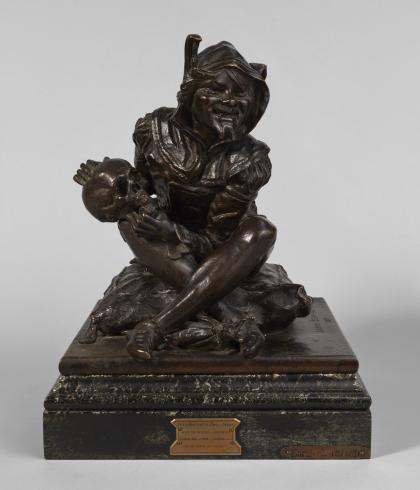While the sculptural work of Sarah Bernhardt has long been eclipsed by her theatrical glory, its qualities, recently rediscovered, are no longer contested today. Sculpture represented more than a pastime for Sarah Bernhardt; it was very much a second vocation.
Sarah Bernhardt began practicing sculpture in the 1870s. She took lessons with the sculptors Mathieu-Meusnier and Jules Franceschi and followed courses in anatomy, but her training remained largely autodidactic. From 1874 to 1897, Bernhardt exhibited regularly at the Salon des Artistes Français. The naturalism of her first works (such as Après la tempête (After the Storm), a group piece exhibited in 1876) soon gave way to a style marked by Symbolism, perfectly illustrated by her Autoportrait en chimère (Self-portrait as Chimera), dating from 1880, which today undoubtedly remains the artist’s most famous and most abundantly reproduced sculpture. Sarah Bernhardt clearly enjoyed practicing across highly varied genres, from monumental works to small decorative sculptures and portraits (see the bust of Victorien Sardou, bronze, 1900, Petit Palais). Her sculptures inspired by seaweed, exhibited at the Universal Exposition of 1900, are surprising in their almost “avant-garde” novelty, and attest to a fascination with the plant world close to that of the Art Nouveau artists (as demonstrated by her dagger with a seaweed design, acquired in 2014 by the Petit Palais).
This sculpture was one of the first works produced by the actress. Dating from 1877, it is inspired by the character of Triboulet, the unfortunate hero of Victor Hugo’s Le Roi s’amuse, a play written in 1832. Triboulet, court jester to Francis I, cannot prevent the King from seducing his daughter. In despair, he attempts to assassinate Francis I, but the plot fails and in the end the jester kills his own daughter as the result of a tragic case of mistaken identity.
In Sarah Bernhardt’s sculpture, Triboulet is easily identifiable by his medieval jester’s costume. His face haggard, he holds a skull in his hands, perhaps that of his daughter, as if meditating on the vanity of existence and the horror of death, like a second Hamlet. Although this bronze bears on one side verses taken from Baudelaire’s Les Fleurs du mal, the sculpture in fact pays evident homage to Victor Hugo. The man of letters and the actress were mutual admirers, and Sarah Bernhardt played many of Hugo’s theatrical heroines on the stage. In 1877, the very year in which she created this sculpture, Sarah Bernhardt triumphed in the role of Dona Sol (Hernani), so it is hardly surprising that she should have been inspired by the theatre of Hugo for one of her first sculptures.
That Bernhardt should have chosen the character of Triboulet is hardly surprising either, given her well-known fascination with death. The verses by Baudelaire, taken from the poem “A Carcass” (Queen of the graces, you will even be so / When, the last ritual said / Beneath the grass and the fat flowers you go / To mould among the dead) further reinforce the horror of the scene and its macabre nature.
Only a few copies of the sculpture The Fool and Death are known to exist. The Despiau-Wlérick Museum in Mont-de-Marsan holds a terracotta sketch, and the Musée des Beaux-Arts in Dijon has a bronze proof in the same dimensions as the bronze acquired by the Petit Palais.
C. C.-V.

City of Paris municipal collection's website
The collections portal can be used to search the collections of Paris’s 14 municipal museums (approximately 336,000 works, including 43,000 belonging to the Petit Palais).
It is also possible to download around 12,000 images of the museum’s works free of charge.
Access the Museums of the City of Paris collections portal
Extern databases
Discover a selection of databases online presenting works from the Petit Palais or documents concerning the history of the museum.

